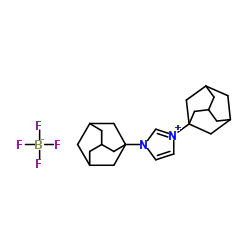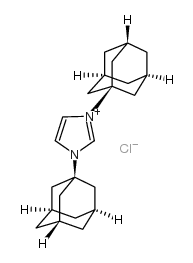131042-77-8
| Name | 1,3-bis(1-adamantyl)-2H-imidazole |
|---|---|
| Synonyms |
1,3-di-1-adamantylimidazolin-2-ylidene
1,3-di-1-adamanthylimidazolin-2-ylidene |
| Melting Point | 240-241ºC |
|---|---|
| Molecular Formula | C23H32N2 |
| Molecular Weight | 336.51400 |
| Exact Mass | 336.25700 |
| PSA | 6.48000 |
| LogP | 4.59850 |
| Index of Refraction | 1.641 |
|
Section 1: Product Identification Chemical Name:1,3-Bis(1-adamantyl)imidazol-2-ylidene, min. 98% ARDUENGO'S CARBENE CAS Registry Number:131042-77-8 Formula:C23H32N2 EINECS Number:None Chemical Family:organic amine Synonym:1,3-di-adamantylimidazol-2-ylidene
Section 2: Composition and Information on Ingredients IngredientCAS NumberPercentACGIH (TWA)OSHA (PEL) Title Compound131042-77-8100%no datano data Section 3: Hazards Identification The product is an irritant to the skin, eyes, mucous membranes and upper respiratory tract. Ingestion of small Emergency Overview: amounts are harmful. Primary Routes of Exposure:Ingestion, inhalation of dust. Eyes and skin. Eye Contact:Causes moderate irritation of the eyes. Skin Contact:Causes slight to moderate irritation of the skin. Inhalation:Dust is irritating to the nose, mucous membranes and respiratory tract. Ingestion may lead to sleepiness, dizziness, abdominal cramps, vomiting, bloody diarrhea, weakness, and Ingestion: convulsions. Acute Health Affects:Irritating to skin, eyes and respiratory tract. Chronic Health Affects:No information available on long-term chronic effects. NTP:No IARC:No OSHA:No SECTION 4: First Aid Measures Immediately flush the eyes with copious amounts of water for at least 10-15 minutes. A victim may need Eye Exposure: assistance in keeping their eye lids open. Get immediate medical attention. Wash the affected area with water. Remove contaminated clothes if necessary. Seek medical assistance if Skin Exposure: irritation persists. Remove the victim to fresh air. Closely monitor the victim for signs of respiratory problems, such as difficulty Inhalation: in breathing, coughing, wheezing, or pain. In such cases seek immediate medical assistance. Seek medical attention immediately. Keep the victim calm. Give the victim water (only if conscious). Induce Ingestion: vomiting only if directed by medical personnel. SECTION 5: Fire Fighting Measures Flash Point:no data Autoignition Temperature:none Explosion Limits:none Extinguishing Medium:carbon dioxide, foam or dry powder If this product is involved in a fire, fire fighters should be equipped with a NIOSH approved positive pressure Special Fire Fighting Procedures: self- contained breathing apparatus and full protective clothing. Hazardous Combustion andIf involved in a fire this material may emit toxic fumes of nitrogen oxides. Decomposion Products: Unusual Fire or Explosion Hazards: Flammable solid. No unusual fire or explosion hazards. SECTION 6: Accidental Release Measures Small spills can be mixed with vermiculite, sodium carbonate or other suitable non combustible adsorbent and Spill and Leak Procedures: swept up. SECTION 7: Handling and Storage Handling and Storage:Store cold, in a tightly sealed container under an inert atmosphere of nitrogen or argon. SECTION 8: Exposure Controls and Personal Protection Eye Protection:Always wear approved safety glasses when handling a chemical substance in the laboratory. Skin Protection:Wear protective clothing and gloves. Ventilation:Material may form a fine dust. If possible, handle the material in an efficient fume hood. If ventilation is not available a respirator should be worn. The use of respirators requires a Respirator Respirator: Protection Program to be in compliance with 29 CFR 1910.134. Ventilation:Material may form a fine dust. If possible, handle the material in an efficient fume hood. Additional Protection:No additional protection required. SECTION 9: Physical and Chemical Properties Color and Form:white xtl Molecular Weight:336.51 Melting Point:240-241°C Boiling Point:no data Vapor Pressure:no data Specific Gravity:no data Odor:none Solubility in Water:reactive in water SECTION 10: Stability and Reactivity Stability:air sensitive, moisture sensitive Hazardous Polymerization:no hazardous polymerization Conditions to Avoid:exposure to air, halogenated and acidic solvents Incompatibility:strong oxidizing agents, halogenated solvents and acidic solvents. Decomposition Products:carbon dioxide, carbon monoxide, nitrogen oxides, and organic fumes. SECTION 11: Toxicological Information RTECS Data:No information available in the RTECS files. Carcinogenic Effects:No data Mutagenic Effects:No data Tetratogenic Effects:No data SECTION 12: Ecological Information Ecological Information:No information available SECTION 13: Disposal Considerations Disposal:Dispose of according to local, state and federal regulations. SECTION 14: Transportation Shipping Name (CFR):Flammable solids, Organic, N.O.S. Hazard Class (CFR):4.1 Additional Hazard Class (CFR):NA Packaging Group (CFR):II UN ID Number (CFR):UN# 1325 Shipping Name (IATA):Flammable solid, Organic, N.O.S. Hazard Class (IATA):4.1 Additional Hazard Class (IATA):NA Packaging Group (IATA):II UN ID Number (IATA):UN# 1325 SECTION 15: Regulatory Information TSCA:Not listed in the TSCA inventory. SARA (Title 313):Title compound not listed. Second Ingredient:None SECTION 16 - ADDITIONAL INFORMATION N/A |
| Precursor 3 | |
|---|---|
| DownStream 0 | |



